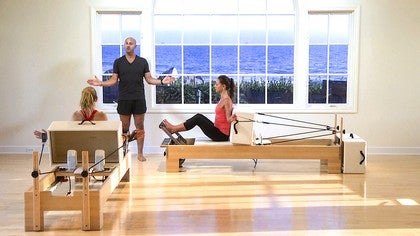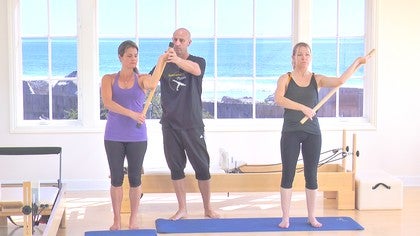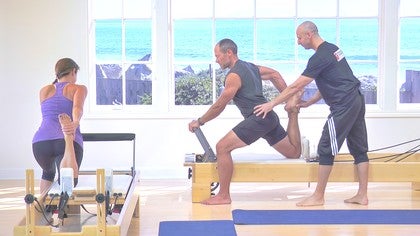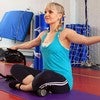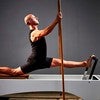Description
About This Video
Transcript
Read Full Transcript
Hi everyone. I'm Anthony left from Melbourne in Australia, and this is the second class that we're going to be doing. And this one's called intermediate innovations in Peloton. So essentially it's about how to stretch. I'm using the polarities reformer. We're going to do, um, what we're calling a full body stretching class. So that means that we're gonna start with the feet or the lower legs, the carves.
Then we're going to work our way up through the muscle compartments of the legs. So the hamstrings, the quadriceps, the hip flexes, the glutes. Then we're going to move on to stretching your spine. And Are we going to try and run through some stretches in all the planes of movement of the spine? And then we might finish with one more stretch for the pectoral muscles and the lats. So, um, I say that it's an intermediate class. There might be times when some of the stretches feel too easy for you.
And then there might be other occasions when they're too difficult because it's very difficult to classify one stretch as being intermediate or advanced. People have variations within their own body, which you might discover as you're doing this at home and you two might find that as well. Um, and also there are things like differences in the structure of your joints. For example, your hips and shoulder joints that do allow you to do some stretches and make other ones more painful. So follow along. If you can't do the variations, then um, just sit that part out if you need to. We spoke about the technique called contract relaxed, which is what we're doing today. We're going to use that technique during our stretching and Meredith and Amy both know how that works and um, rather than me going through it again, if you refer back to the beginner's class that, um, is also on politeness.
Any time you'll see a fuller description of how that works. Okay. The final thing I want to say before we start is that I'm stretching is, requires a slightly different attitude to your workouts than does other forms of exercise. You need to be very calm, as relaxed, as possible, as patient, as possible, and keep still once you're in the stretch and whole thing. So it's not a dynamic class that requires more stabilization and more relaxation. So you can't force your muscles into stretching. I have to give why and that is a result of you being in that frame of mind to some extent. Okay, so let's start off, um, with the calf muscles of the lower leg. And what I'll get you guys to do is, um, the springs that we've got on our, what we call medium, which is a balance of holding the carriage out so that it doesn't out, but it's not too strong that you're having to hold so strongly.
Just prevented from coming in. So what we might do is I'll get you to stand on the carriage like this. We'll, I'll show you first. So your heels both heels back against the shoulder rests and hands on the bar. And then I'll talk you through the exercise. From there. So heals are against the shoulder rests.
And what's important here also is that you don't allow the foot to roll inwards like this because if you do that, you'll avoid stretching some of the muscles down the side of the lower leg here, which are just as important. So if you feel that your artists have rolled in, just shift your weight onto the outside of the the foot a little bit. Now that you're in position, if you can move the carriage out to the point where you start feeling a stretch either in the cars or in the hamstrings, and then just hold still. You're both feeling a stretch there. Yeah. Okay, so we're going to hold that for five breaths and then we're going to do a contraction. So just breathe, relax, try and keep the shoulders away from your ears if you can. So Amy, if you can, that's right. Broaden the shoulders a little. Now we're going to do a contraction.
So we're going to push the balls of both feet as if you're accelerating in a car. We're going to push both feet down into the carriage for a count of five. So let's do that now. So press the feet down. One, two, three, four, five, stop pressing, take a breath in and as you breathe out, the way that we make this a bit more intense is to lower your chest a little more deeply so that it's in line with your arms and point your bottom up a little more. Does that feel a bit stronger?
And then we're going to bend this knee and lift your heel to the ceiling using the glutes. Good. That looks lovely. Without rolling the hips. So the hips are nice and level, the glutes are working hard and the muscles of the stance leg should feel that it'd be more strongly. Now you both feeling there. Good. That's the way. So let's lift the heel a bit more if you can. Good. This is also a great glute exercise and also very good for the shoulder stability. Now I don't know if tri, if I'm, he's Christy told you, but we're holding each stretch for about 30 minutes. Okay. Now you know. Okay, so that'll do.
If you can slowly put that foot down, put it back in front of the shoulder, wrist. You want to have a break before you do the other side? No. Okay, so before we lift that leg, lower the chest point your bottom up so that your arching through here as much as you can. Then lift the other leg, point it behind first contract the glutes, pain the knee and lift. Good. Now try and hold for 10 breaths if you can. Good. That's very nice. If you're at home, just make sure that the stance leg is staying straight and the hips are level, which they are, and then keep lifting that heel towards the ceiling.
Okay. So coming out of the stretch, just put the heel down, bring the carriage in slowly and just lift your head up slowly to come out of the stretch. Very nice. How was that? Okay. Alright, now we're gonna move on to stretching deeper into the upper part of the hamstrings and the glutes and some of the adductor muscles. So what we'll do is, um, let's put the bar down. So it is here. That makes it a little bit easy to get into position.
What I'll do is I'll just show you how to start the stretch and then you can carry on from there. So this time we put your front foot on the bar in line with your bottom bone and we're going to do what we call a bent legged stretch here. That means that rather than straightening the leg, we're keeping our chest in contact with the leg. And we're going to stretch these muscles by slowly opening this angle. So it's going to look like this.
I'm going to push the foot into the bar and slowly see him opening out this angle. So that's what we're doing. So let's do that. If I think, if you have, um, a medium spring just to experiment with that and we'll see how it feels. You don't want to light otherwise be doing this blitz a week too soon. So let's try that. So if you put one foot up on the bar, yeah, remember that your legs should be parallel. And before you, before you start, just push your back leg back and low your hips as much as you can. So we're going to call that the starting position. You both okay there?
Yup. So the first thing that we're going to do is use the quads of this leg. So push the foot into the bar and slowly slide the carriage out. And when you start to feel a stretch under here, that's not too strong. That's the first position and we stop and hold you both feeling there. You might also find that you feel a stretch in the hip flexors here of the back leg. That's not a problem.
It just means that they could do with some stretching as well. Okay? All right, so we've held the first position for five breaths. Now we're going to activate or contract. That means the same thing, the muscles and here, the ones that we're stretching. So to do that, push this foot downwards into the bar without too much force, sort of 30 to 50% of your maximum. So let's do that now. So push down. Five, four, three, two, one, stop. Take a breath in. And then as you breathe out, push the carriage out again
Only this much off the carriage without lifting your hips. Good. Can you feel how that makes it a bit stronger? The reason for that is that your, your pelvis is rolling further forward and the pool and the here is getting stronger. Okay. So this is another 30 minutes stretch. How are other things that you can attend if you want a lifting the chest a little, that'll make it nice now as a okay. Had enough. You sure? Alright, so put your knee down, bring the carriage in slowly. Okay. It looks like you did get a stretch there and I think we're running a bit short of time.
We won't be have time to do your other leg. All right, we'll do the other way. Yeah. So this time again, the placement of the foot should be in alignment. The bottom bone. Push the back leg back first so that you can sink the hips down and there's your starting. That's nice. Starting position. Now try and straighten the front leg, but keep your chest in line with your leg or in contact with Renee. Good. That's nice. So you go to the first position and we hold good, so they're nicely aligned. Those hips there.
Try and try and keep as still as you can. The more that you move, the more that your nervous system becomes excited and the less relaxed and stretchable you are. Okay, so now we do that contraction. So we're going to press this front foot down into the bar. So one, two, three, four, five stop. Take a breath in. And then as you breathe out, use the front leg again. So the quads of the front leg to push a little deeper into the stretch. Good. And you'll probably find that your back starts to round a little less.
That's normal because the muscles are pulling it in that direction. But if you can try and keep your spine as long and straight as possible.
You just contract the quadriceps and see if he can lift that back nave, even if it's just the tiniest bit good and hold still. And you'll notice that the muscles of the back leg are doing quite a lot of work at the same time. So although we calling this stretching, it's actually quite strong isometric muscle strengthening work as okay enough. Put the knee down slowly and slide the carriage in carefully. Very good. Okay, so we've worked the back of the legs. Now we're going to do some work for the inside of the legs. Um, I might get you to hop up and put the bar down, so out of the way, and I'll just hop up on your one for a minute. Meredith, I want to just check the springs because we, this time we're going to do an inner thigh stretch.
So probably that grain spring there is enough. Okay. All right. So can you see how I'm positioned here? So both feet are in the same line. I'm supporting myself with my arms and we, again, we're just pushing out to the point where we start to feel a stretch on the inside of our legs. Okay, so let's try that. Don't push too hard. Um, I think we'll try that just in case it's better if you're not sure that you have too much resistance than not enough and I can, we can bring it in and adjust it. So pop one foot on there, the other one in front of the shoulder, wrist, just so that it can slip and slowly push the carriage out.
Using your abductors for the muscles on the outside of the legs. Just push out until you start to feel a stretch. Good hold still. And both of you look very nice there. If you're doing this at home, have a look at the nice shape through the spine. So pointing the bottom up is very nice. Keeping the back long and straight and support yourself with your arms as much as you can.
Okay, so the contraction here is first of all, tightened the quadricep muscles. These ones here just to support your knees. So those all important VMI muscles that we talk about a lot in Polarez, tighten them up and then without letting the carriage move, see if you can pull your, imagine. We'll make the effort to pull your legs together. So let's do that now. So one, two, three, four, five stop contracting. Now just go carefully here before you push out, bend your knees a little, a little bit more. Lower your hips. Now raise, straighten your legs and push out further. Good. So that was quite significantly further.
Sometimes if you bend your knees in this stretch, low your hips, then restrain them. You'll find that you can move out a lot further. Now see if you can hold that there. The way to vary this if you want to, is to lean your bottom backwards. Just whatever you do, go very slowly because your muscles are at and rain. So everything has to be done very cautiously. If, for example, your right leg Meredith, let's say this one was a bit tighter, what we could do is just very carefully then this one a bit.
And so we slacking off the muscles in this leg and we stretch this one a bit more. So if there's a tighter side that you've got at home, you can always bend the leg of the other side. Okay. So coming out of this stretch, I'll just show you how to dismount. We're going to go up into a full handstand and then do a back plate. Now Bend your knees and bring the carriage in carefully. And just be careful as you take yourself off.
Good. Okay. Sometimes it feels a bit odd after that, you feel like you're walking on us. Okay. So next we're going to do a stretch for the quadriceps. Um, I think I'll demonstrate the start of the stretch for you and then you can carry on from there. We'll put the bar up for this one. And I think, yeah, the springs that we've got, what would, what were, they were sort of a medium resistance, so we'll stay with that. And, um, I'll show you how to get into this stretch. The first thing you need to do is grab a hold of your ankle this way and put your knee, well, not the knee cap, but just above the kneecap. Back against the shoulder rest here. Okay.
And then the other foot is underneath the bolt here. Okay. That's your first position. Then you need to make sure that your hips are square to the line of the leg. Okay? So there's your first position, and then we're going to hold and eventually I'll show you what we do. We pull the foot towards the bottom and then we roll down onto the fly this way.
Okay? But we'll get to that. All right, so let's try that. So grab a hold of your foot first. If this is very uncomfortable on the knee, we can put some padding under it, but try and make sure that this part of your leg is on the carriage, not the actual knee cap. Okay, good. It's a little awkward getting into position, but once you're there, it's okay, I think. All right. And the front foot's underneath the bolt. Yep. Now reach around and hold. Can you hold that leg? Good. So the first thing that we do is a little bit of tension in the abdominals, polio foot in towards your bottom to wherever it is that you start to feel a stretch in the quadriceps. You're getting that? [inaudible] what about you? I'm [inaudible]. Yeah.
Okay. That's okay. All right. So that's, that's the first position. So we hold that again for five and then we can tract by pushing our foot back into our hand. Okay, so let's do that now. So you're pushing your foot into your hand in this direction without letting it move. So one, two, three, four, five, stop. Take a breath in. Make sure that your hips is still in the right position and as you breathe out, Paul, that 14 a little closer. Good. I can feel that's probably far enough for you, Meredith. Good. I mean, just got to watch with the lumbar spine that it doesn't extend too much.
That's better. And that'll make the stretch stronger anyways, you pull in here. Okay. It's still there. Good. The next thing we're going to do is to lower your hips. So bend the front knee and go down a little more. When you do that, make sure your foot doesn't move back.
So it's just sinking the hips down directly by bending this knee. Can you just come up a little bit? It's just so that we can show that again. So here and then down. Okay, good. That's a bit quite strong I think I usually, yeah. Good.
The form that you're holding is really nice. Both of you. Okay. That's probably long enough. Let's come out of the street. So bring the carriage in, slowly lift yourself out and let, let's try the other side if you can, if you can hobble towards the other side. Good. So I'll just help you with this position. So try and that's the why I get that just above the kneecap. Yep.
And then the other foot up there, reach around. Very nice. And then if you can Meredith, yeah. Rates around and pull that 14 towards the bum bottom. Your bottom part. Yeah.
So that's normal. Uh, well actually it's not normal. It's serious. A serious problem. But we'll till we can talk about that later. I won't do this publicly, but I'll tell you why. Okay. So first contraction is pushing your foot back into your hand.
One, two, three, four, five. So take a breath in and then try as much as you can to let your leg relax and pull your, your foot in closer towards your bottom. Very good. So how old there now usually I'm the advanced. The next move I'd probably would say when your foot's right on your bottom, it's probably ready for the next move. But let's just do it anyway. Today. Things you did it on the other leg, which is if you can bend your front name or in low your hips, slide the carriage out a bit more so that the middle of the quads are contacting the carriage. Now good. And again, Tuck and tilt. Good. And when you do that, make sure your foot doesn't move back.
Another thing that you can try is just to rotate your hip around a little more. Yeah. And you'll feel that more on the lateral part of the quadricep. Can you feel that?
How are the legs? Yeah. Hello? I said, um, that, you know, it's stretching but it's actually quite hard work physically to hold yourself there too, isn't it? Yeah. Okay. So we've worked our way up the legs. We haven't done any stretches for the glutes yet. I might get you in, I'll demonstrate how to get into position again and then you can try this one. Um, we'll leave the bar where it is.
So what we do first is kneel on the carriage and lift your foot. So I'll use my right foot here. I'm going to lift it up and place my ankle on the bar here. And then I need to rest the whole of my lower leg on the, on the bar this way. Okay. If you can't do that, you're probably not ready to do this stretch, but I think you two will be.
It also can be because the structure of your hip joint doesn't allow your leg to lie like this. So if you can't do that, just leave it and um, have a look at the first video where we showed a simpler version. What you notice when you get into this position is the tight muscles pull you in this direction. So what we're going to try and do is level our hips this way. Okay. And lift our chest. All right, let's see how that feels. The springs probably don't need to be too heavy. Um, I think we'll try the red a little lighter than not. Yeah.
One Red Spring and we'll see how that feels. So the one foot here against the shoulder rest, let's do the other leg. So this one here where you can lift that foot up and try and lie it along the bar. That looks good. You both okay there. All right, so that's a nice first position. And the next thing is I said is to make sure that your hips are level, which they are. So you both getting a stretch here. All right, let's just hold that for now. Diner wise, have to go into the most extreme position. Sometimes it's better just to haul things and relax into her.
Okay, so let's do a contraction. So we're going to push the foot. This leg, the one that's on the bar down. So let's do that. Now one, remember we're using only about half your maximum strength. Two, three, four, five, stop. Take a breath in. And then as you breathe out, let's see if you can tilt your pelvis further forward and push this leg back a little. Can you push a bit more? That's better. So what happens is as you push this leg back, your pelvis rolls forward a bit and it becomes a bit stronger. Yeah, good. So hold still.
So we weren't moving your whole body away from the bar. It's just pushing that leg back. Okay. Now we have one final variation here, which is where we're going to just lift that back knee a tiny bit and push back. Push back a bit more. Meredith. Good. Now try and hold a you'll that. Hmm.
Okay. Alright, so I just popped in a down slide the carriage in slowly and let's try the other side. So you need to, I think the easiest way to get into it is to actually lift the other foot. Yeah, place it along the bar. Position the other foot against the shoulder rest and good. If you can stay there for a minute. Amy, let's assume that you're a bit tight.
So you were like this. So the first thing that we're going to try and do is to just level your hips. And that in itself might be enough to start with. So let's just hold that
Think of sinking the hips down and pushing that leg back a little. So the stretch should be filled anywhere around this region. Don't fall off. Can I have that text there? All this drawing. Now. Lastly, let's just take the white onto our arms and see if we can lift this knee up and push without lifting your hips. Just lift the knee and push back. Good.
Hips as much as you can hold still. Let's just see if he can give it one final push little bit further and hold for a couple of seconds.
Yeah. So much better. You feel. Okay. Good. All right, so let's move on to stretching the spine. Um, first we'll do a side bend and I'll show you this one, which is, I'm not particularly strenuous. The difficulty is getting into position. We'll just move this far out of the way and try it with a red spring, Amy, and we'll see how it feels. I'll just demonstrate to you how to get into position. So we're going to have our legs through here.
Actually you'll need more than a red spring, probably a red and a blue. So we push the carriage out first. That's important because you can't get in position with the carriage in. So push out, straighten your legs and roll this top hip forward. So there's a straight line through my legs, my chest to this hand.
And then as the carriage comes in, you'll see what you find is that a stretch develops. And here, see how my spine is being bent further or curved. And so the stretch is coming on down here. Okay. In some of the I Blake muscles and quadratus lumborum some of the muscles deep around the spine. So we hold that for awhile and then I'll talk you through some of the variations. Okay. All right. So you try that spring, it might be a bit much for you, but we'll see.
How does that feel? You feeling a stretch there? Yeah. What about you, Amy?
Breathing again. You'll notice that the top part of your ribcage here is compressed and so won't be able to expand very much. So breathe deeply and your, your diaphragm will press the lower part of your abdomen out here, which will make the stretch even stronger. So deep breaths. And now we'll do a contraction. So we're gonna press both feet or both legs. Sorry. Down into the carriage as if you're pushing them into the floor.
So let's do that now. So one, two, three, four, five, relax, breathing, and then slide the carriage in a bit more to restretch. Okay. How's that for you Meredith? Okay. Yep. Now, how you can vary this. There's, remember there's lots of muscles under here, Ryan running in lots of different directions. So let's try rolling the top hip forward a little and you might find the stretch moves around a little. You might even like to try taking this leg and hanging it over the side. Sometimes that likes the stretch a little stronger as well.
Then straighten the legs, make sure of the alignment and then slowly slide back in. Yeah. Cool. That's the why. So straighten the legs, roll that top hip forward. So the Trina's straight long line. Then let the carrots slide in slowly until you start. This is a nice angle because you can see the nice curve through the spine here.
So hold, still, remember to breathe as deeply as possible. And now let's press both legs down into the carriage. So one, two, three, four, five, relax. Breathe in. And remember, always restretch on it. Breath out because your body's slightly more relaxed at that point.
Now you can experiment with rolling the hip forward if you want.
We've, so we've only done some side bending. Um, I'll just show you this one. We're going to sit and we'll put the bar up like this. Am I going to sit with our legs against the sidebar? The spring resistance doesn't really matter because we're not moving the carriage. So I'll put a, put a few more springs on just to keep the carriage still. So as sitting with our legs braced up against the sidebar, lift your chest and then reach around.
So that one arms here and then the other one goes here. Then what we do is again, lift your chest, pull with this arm and push with this one. So it looks like this.
Lift your chest, and then let's see if you can get the other hand around. Good onto the first shoulder rest later on. We might try and get it onto this one, but for now that's plenty. Okay. So let's lift the chest and use this arm to pull the other one to push and see if we can get those shoulders round a little further. Good.
So hold still because your abdominal muscles are pulled very around the spine here. You find that your breathing is quite limited. So try and overcome that by breathing as deeply as you can. So Amy, make sure that you're pulling on the bar in this direction, not back towards you.
So try and twist back to the start, but hall's deal with the arms. One, two, three, four, five, take a breath in. And then as you breathe out, use your arms, lift your chest, use your arms to pull you around a little further. Good. Amy, if you can pull those solid blades together, that will assist with your breathing as well. So deep breathing.
Good. So that's a lovely, lovely starting position. Both of you with the nice long spine. Now pull with this arm and press into the bar with the other one. I mean if you put your hand here and push into it more, yeah, you'll be able to get more use out of it. You can bend your elbow a little. Yeah,
[inaudible]
Okay. When you've had enough, just come out of this stretch slowly. Very good. Okay, so let's try two more stretches for the spine. We've done side bending, we've done rotation. We're going to do a little bit of flection. You can both just sit back on the carriage and put both feet up on the bar. Good. Hold onto the bar on the sides and I'll take a couple of springs off there.
So you've got a green and a red spring there. Okay. This is um, this is called a posterior stretch often in yoga because basically all the muscles on the back side of your body are being stretched from the neck, the middle, and lower back, the glutes, the hamstrings, and the carves. So depending on where your Titus, that's where your feel at the most. Let's very slowly push the carriage out. Let your head relax. Just push without straightening your legs just yet.
If you can straighten them, just go to the point where they're slightly bent for now. Let your head relax. And how old are you both feeling a stretch somewhere on the posterior aspect of your body, Amy?
So be careful that your feet don't slide off the bar here, but lift your heels a bit and press the balls of your feet down into the bar. So one,
And also if we wanted to focus it more in the hamstrings, we could art your back the other way. So attempting to straighten the spine. Okay. But just relax again. Now let your head drop and let's come out of the stretch very slowly. Just bend your knees and bring the carriage in.
Okay. So how about let this go and you take a seat here. Facing the other way. I'll help you to get into position two. Good. So if you sit right up this end of the carriage and lie back so that the bottom part of your shoulder blades, just contact the bar. Put your hands behind your head. Good.
Hard to know where it is. Yeah, good. Let your legs relax. Take your hands behind your head and lie back carefully. And how has that feeling? Okay. Now because we're calling this an intermediate class, you might find that you are able to take your hands away from your head. It depends on how it feels on your neck.
If you feel this in the shoulder joint, then probably better to stop and I'll show you an alternative position. How does that feel? Okay. I could pull on one arm a little more to stretch one side or the other. And the alternative position for those of you who feel that in the shoulder joint is to put the hands together, Bend your elbows, and that way your shoulders, it turned out a little more and there's a little less compression or impingement in the shoulders. I'm just going to pull a little bit on you. How does that feel? Do you want me to push more?
Try and relax the tummy and the legs. Okay. Now let's put both hands behind your head. We need to come out of this very carefully. Use your arms to lift your head up, Tuck you cine. Good. Tighten your tummy. Just take your hands off and put them on the sidebar and use those hands to lift you up. Yeah, good. And then often after you've done such an intense back, then it's nice to be in for just to, as a counter stretch.
I should just say that if any of you, when your head's back like that, start to feel dizzy, then this is a stretch that you should leave. Okay. So let's get up and stretch that stretch there. You may have felt under here and I noticed with you Amy, your, your um, set up a bit, which indicates that there might be some tightness in the let's. Okay. So let's focus on your lats for this, for this last stretch, I'll just take these out of the way.
If you can just change the springs so that you have two, two very light springs. And if I can just use your reformer for a moment, I'll show you this stretch. We sit on the side this way and put so almost parallel with the bar and then reach around and then we the carriage out until that chest is inline with the alarms. So it looks like this. Okay. It doesn't matter if your bottom lifts up. That's the first position. Okay.
Let's try that first and then I'll talk you through the rest. That's right. Yep. So reach around with both hands. Have this hand slightly more in the middle. Yep. Move the carriage out. Slowly. Keep going as far as you can so that your chest is right down in line with your arms. And as I said, it doesn't matter if bought bottom or part of your bottom lifts during this one.
That's the first position. Now to make the stretch a bit stronger, lean your shoulders side just directly sideways, away from the center of the carriage. So that's, that's right, Meredith's so away from the center. You're both feeling that stretch. It should be under the arm and part of the triceps and in the lats running down the side of your spine. And as I said to you earlier on, it's difficult to breathe sometimes here, but the, the full of that you can make your breath, the more effective the stretch will be. So breathe as much as you can and fill up this part of your spine. So we're going to do a contraction here.
This time we're going to try with the outside arm to pull it as if we're trying to lengthen the bar. So I mean, just put your hand more on top as if you're trying to make the bar longer. So pulling outwards. One, two, three, four, five, relax. Breathe in. And as you breathe out, lean a little further. Good. And you can try pressing the other hand into the bar. And one final variation is that we're going to keep leaning, but lift the outside shoulder.
This one above the other one and you find that that feels quite different again. Good sir. Rise that outside. Solders. They were still leaning away from the middle of the carriage, but we're lifting the outside shoulder. Okay, so let's relax the arms and bring the carriage in slowly. And how did that feel? Did, did we hit the spot? Yeah. Okay, let's do the other side.
So reach around both hands on the bar. Push the carriage out slowly and lower your chest. So out to the point where again, when we start to feel a stretch here down the outside of the spine and under the arm, that's good. And then laying the shoulders away from the center of the carriage and keep breathing.
And our final variation is to lift this outside shoulder up. Very nice. So we're leaning away from the middle and then we're raising the outside shoulder. Just hold for another five deep breaths. And slowly while you're coming out of this stretch, I'm just going to get a box. And last one you felt that one. Good.
So the final stretch, we're going to use a box and we're going to stretch some small muscles in the shoulders, the rotator cuff muscles, which you know, a lot of people because of the way that we use our arms these days with keyboards and mouses and so on. We tend to have very short rotator cuff muscles because their arms are turned in so much. So we're going to practice turning them out was, so what we need here is, um, reasonably heavy resistance. So let's try to red springs and I might just demonstrate it's a slightly tricky position to get into. I'll just see it and push the carriage out. And I might, Meredith, if you could just pass me the straps, the from there. So this is our starting position.
We hold the straps like this and you'll, you'll notice if you can see clearly my arm here is at 90 degrees and the box is to hold my elbows in. And then as I bring the carriage in, you can see the by my arms, uh, turned out with my upper arm is being rotated outwards. Okay. So you move to the position where again, where you start to feel a stretch in the shoulders and then hold still. Just be careful that you don't apply too much weight back into the box. We don't want it to tip up when you're finished. Just do what I'm doing.
Just drop the straps if you're on your own and bring the carriage in. I think you might need a little bit more spring resistance. A bit heavier is better because you're going to be controlling the carriage movement with your legs. Okay. Oh, that'll be enough. Okay, so I'll get you to, to push the carry down and then I'll pass you the straps. Okay. You're comfortable there.
What's happening? Okay. Just um, let me straighten it up. Can you might have to let go for a minute. Could be too heavy. You've got to just be careful with this, that you don't lean back too strongly into the box. Can you just move forward for a minute so I can get that box out there? We are you. I was going to say that we could put the vox vertically, but for today, let's just leave it like this and see if we can manage. So this time just be careful not to lean back into it too much.
So push the carriage out.
So Ho just very slow movements using your legs to control the carriage. Now you're in position. You can slowly bend your knees and let your hands be drawn backwards. Are you feeling, it looks like you're getting a straight training. What about you? Okay, so Meredith is, is, I'm a little looser and what you might find eventually is that the, the box will block the movement of your arm when you get to a certain point and that's when that happens. Then a Gel, stop the stretch and put the box vertically. Okay.
All right, so you're both feeling that it should be, as I said, round quite precisely in the shoulders where the muscles attached here. Let's do a contraction. So no movement, but as imagine that you're going to clap. So you're pulling the hands forward. So one,
Now if you happen to have an arm or, um, I think you both got two, but if you have one that's tighter, turn away from it slightly and you might feel it. Get a bit stronger in that. Um, okay. Now to come out of this stretch, straighten your legs. Just drop the straps. Good. And bring the carriage in. Okay. So just to, in summary, we've worked on all the muscle groups of the legs. We've moved the spine sideways, backwards, forwards, and rotation.
We've stretched your lats and we've done some of the muscle groups of the shoulders, so you both feel okay. Good. All right, well, thanks for joining me in
Feel the Length: Innovations in Pilates
Comments
You need to be a subscriber to post a comment.
Please Log In or Create an Account to start your free trial.
